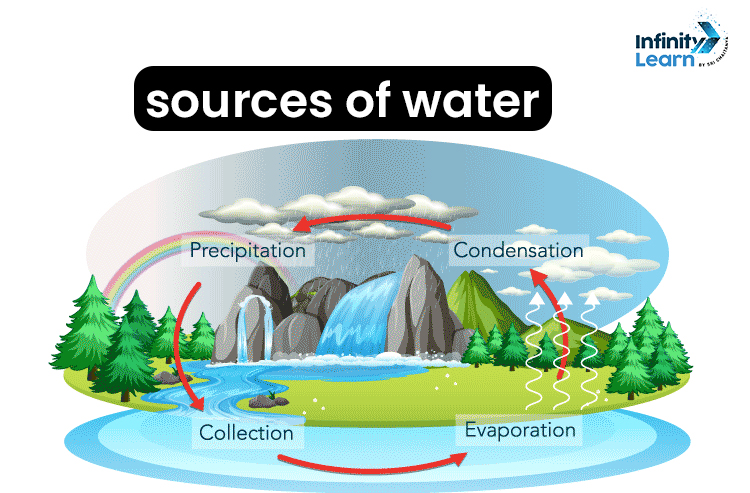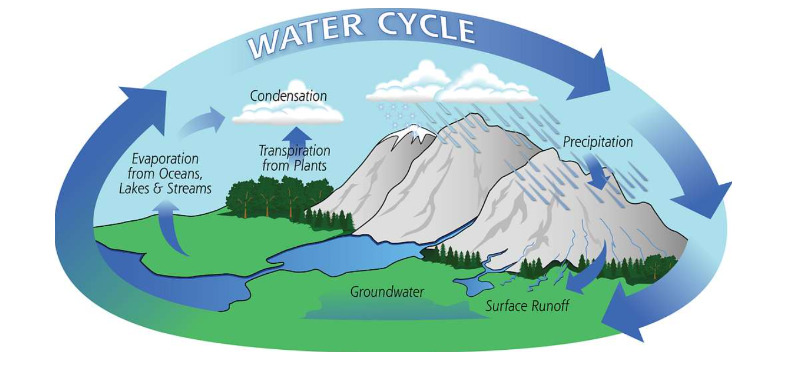Table of Contents
Water is an essential and versatile substance that plays a crucial role in supporting life on Earth. It covers about 70% of the planet’s surface and is found in various forms such as oceans, lakes, rivers, glaciers, and groundwater. Let’s explore water in more detail, including its introduction, use, sources, importance, and the water cycle.
Water is a chemical compound composed of two hydrogen atoms bonded to one oxygen atom, resulting in the chemical formula H2O. It is a transparent, tasteless, and odorless liquid that exists naturally in all three physical states: solid (ice), liquid (water), and gas (water vapor). Water molecules are known for their unique properties, including high surface tension, excellent solvent capabilities, and high heat capacity.
Water sources are places where we get water. Common sources include rivers, lakes, reservoirs, groundwater wells, rainwater, and the process of turning seawater into fresh water. These sources are essential for drinking, farming, and industries. Natural springs and glaciers in the mountains also provide clean fresh water. It is important to protect and manage these water sources to ensure that communities worldwide have a safe and sustainable supply of water.
Sources of Water Definition
Sources of water refer to the natural outlets or origins from which water is obtained. These sources can include rivers, lakes, reservoirs, springs, wells, and groundwater aquifers
Sources of Water Image

Use of Water
Water has a wide range of applications and is utilized in various sectors. Some common uses of water include:
- Drinking and hydration: Water is essential for maintaining proper bodily functions, regulating body temperature, and transporting nutrients.
- Agriculture: Water is crucial for irrigation, ensuring the growth and productivity of crops.
- Industry: Water is used in manufacturing processes, cooling systems, power generation, and cleaning operations.
- Domestic purposes: Water is used for cooking, cleaning, bathing, and sanitation in households.
- Recreation: Water provides opportunities for swimming, boating, fishing, and other recreational activities.
Sources of Water
Water can be sourced from various natural sources. Here are the primary sources of water:
- Surface Water: This includes water bodies on the Earth’s surface, such as rivers, lakes, ponds, and reservoirs. Surface water is often used for drinking water supplies, irrigation, industrial processes, and recreational activities.
- Groundwater: Groundwater is the water present beneath the Earth’s surface in saturated layers of soil or rock called aquifers. It is accessed through wells and is a significant source of drinking water for many communities. Groundwater is also used for agriculture and industrial purposes.
- Rainfall: Rain is a natural source of freshwater. Precipitation occurs when water vapor in the atmosphere condenses and falls to the ground in the form of raindrops. Rainwater can be collected for various uses, including irrigation, household activities, and recharging groundwater.
- Snow and Ice: Snowfall in colder regions and the accumulation of ice in glaciers and polar ice caps are sources of water. When snow and ice melt, they contribute to surface water and groundwater resources.
- Springs: Springs are locations where groundwater naturally emerges at the Earth’s surface. Springs occur when an aquifer intersects with the land surface, resulting in water flowing out. Springs are often used as sources of freshwater.
- Desalination: Desalination is the process of removing salt and other impurities from seawater, making it suitable for drinking and other uses. Desalination plants use various methods such as reverse osmosis or distillation to produce freshwater from the ocean.
It’s important to note that the availability and accessibility of these water sources can vary depending on geographical location, climate conditions, and human activities. Sustainable management and conservation of water resources are crucial to ensure a reliable and adequate supply of clean water for various needs.
Also Read
Importance of Water
Water is essential for sustaining life and supporting ecosystems. Its importance can be understood through the following points:
- Human health: Water is vital for hydration, digestion, and circulation in the human body. Access to clean and safe drinking water is crucial for preventing waterborne diseases.
- Agriculture and food production: Water is necessary for crop cultivation and livestock farming, ensuring an adequate food supply.
- Biodiversity: Water supports various ecosystems, providing habitats for numerous plant and animal species. It is essential for maintaining biodiversity and ecological balance.
- Climate regulation: Water plays a vital role in regulating temperature and climate patterns through processes like evaporation, condensation, and precipitation.
Water Cycle
The water cycle, also known as the hydrological cycle, is the continuous movement of water on Earth as it circulates between the atmosphere, land, and bodies of water. It involves a series of processes that work together to maintain a balance of water on our planet. Here are the key stages of the water cycle:
- Evaporation: The water cycle begins with evaporation. Heat from the sun causes water to change from a liquid state to a gaseous state (water vapor). This process primarily occurs from the surface of oceans, lakes, rivers, and other water bodies, as well as from moist soil and vegetation. The water vapor rises into the atmosphere.
- Condensation: As the warm water vapor rises higher into the atmosphere, it encounters cooler temperatures. The water vapor begins to condense and forms tiny water droplets or ice crystals. These tiny droplets cluster together to form clouds. Condensation also occurs on solid surfaces, such as when dew forms on the grass in the early morning.
- Precipitation: Condensed water droplets in the clouds grow in size until they become too heavy to stay afloat. They then fall from the atmosphere as precipitation. Precipitation can take various forms, including rain, snow, sleet, or hail, depending on temperature and atmospheric conditions. Precipitation replenishes the Earth’s water sources, including surface water bodies and groundwater.
- Runoff: When precipitation reaches the Earth’s surface, it either infiltrates into the ground or flows over the land as runoff. Runoff occurs when the ground is saturated or impermeable, preventing water from seeping into the soil. It collects in streams, rivers, and eventually flows into lakes, reservoirs, or the ocean.
- Infiltration: Some precipitation that falls on land infiltrates into the ground. It percolates through the soil and enters the porous layers, eventually reaching the underground reservoirs called aquifers. Infiltrated water becomes part of the groundwater, which can be accessed through wells or springs.
- Transpiration: Transpiration is the process by which water is released into the atmosphere by plants. Plants absorb water from the soil through their roots and release it as water vapor through small openings called stomata on their leaves. This contributes to the water content in the atmosphere.

The water cycle is a continuous and dynamic process, with water constantly moving and changing its state. It plays a vital role in distributing water resources across different regions, replenishing ecosystems, and regulating Earth’s temperature and climate. It is an essential natural process that sustains life and supports the functioning of various ecosystems on our planet.
FAQs on Sources of Water
What are the 5 main sources of water?
The five main sources of water are surface water, groundwater, rainwater, snow and ice, and desalinated water.
What is the main source of water in India?
The main source of water in India is primarily surface water, including rivers, lakes, and reservoirs. Groundwater also plays a significant role in meeting water demands.
What is the main source of fresh water?
The main source of fresh water is precipitation, which includes rain and snowfall. It replenishes surface water bodies and groundwater reservoirs.
What are the types of water resources?
The types of water resources include surface water (rivers, lakes, reservoirs), groundwater (aquifers), rainwater, glaciers and ice caps, and desalinated water (obtained through desalination of seawater).
How many water sources are there?
The number of water sources can vary depending on the scale and classification used. However, in general, there are multiple sources of water, including rivers, lakes, ponds, streams, springs, wells, and aquifers.
What are the 15 uses of water?
The uses of water include drinking and hydration, cooking, bathing and personal hygiene, irrigation for agriculture, industrial processes, energy production, firefighting, recreational activities (swimming, boating), wildlife habitats, fisheries, sanitation and sewage treatment, construction and manufacturing, transportation, and maintaining ecological balance in ecosystems.
What are the properties of water?
Some properties of water include its high surface tension, excellent solvent capabilities, density anomaly (expansion when freezing), high specific heat capacity, strong cohesion and adhesion, and the ability to exist in all three states of matter (solid, liquid, gas) at Earth's temperatures.
What is the importance of water?
Water is vital for sustaining life, supporting ecosystems, and various human activities. It is essential for drinking and hydration, agriculture and food production, maintaining ecosystems and biodiversity, regulating climate and temperature, industrial processes, energy generation, and overall human health and well-being.
What is in the water cycle?
The water cycle consists of processes such as evaporation, condensation, precipitation, runoff, infiltration, and transpiration. These processes work together to circulate water between the Earth's surface, atmosphere, and back again, maintaining a continuous movement and balance of water on our planet.









